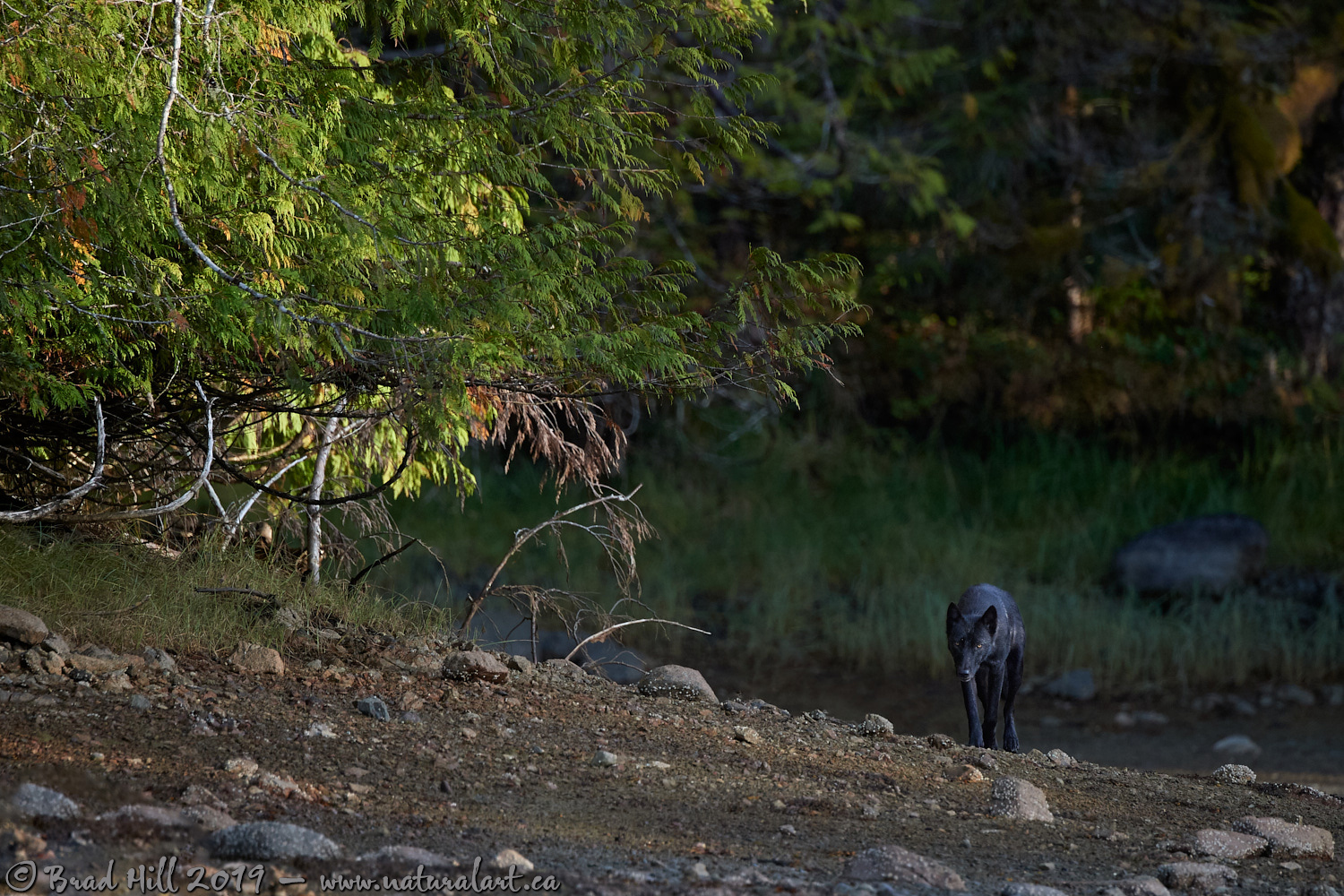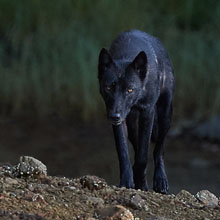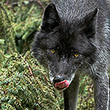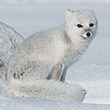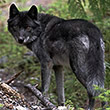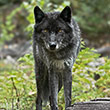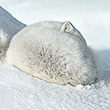Availability: Undetermined - Enquiries?
In the Field
Black Ghost of the Rainforest. Southern Great Bear Rainforest, British Columbia, Canada. 27 August 2019.
Regular visitors to the Great Bear Rainforest - and the handful of locals who live there year 'round - have long known that the area is home to a lot of coastal Gray Wolves. At this point there is no solid estimate to how many wolves are found in this vast area, and this is largely because - owing to decades and decades of persecution - they are so darned shy and elusive. But, you can find their tracks almost everywhere in the Great Bear...and at times the paucity of sightings and the abundance of tracks makes you wonder if they aren't being left by ghosts! ;-)
During the 2019 season we pushed our Great Bear Rainforest photo tours into a lot of new (to us) and difficult to access areas. There are very few visitors to ANY part of the Great Bear, but even fewer in many of the locations we hit in 2019. We did this "pushing of the envelope" for a couple of reasons - in an effort to find white-coated Spirit Bears in new and "fresh" locations, and to find coastal Gray Wolves. And we did well on both accounts! On the trip that I photographed this female black wolf we ended up seeing and photographing 17 wolves, 11 of which were in a single pack. Interestingly, this single pack had a high proportion of black wolves - 5 of 11 were jet black (and another was a fascinating charcoal gray).
In 2020 our plans are to continue to push into these rarely visited areas on ALL of our Great Bear photo tours, including on our spring Great Bear Rainforest photo tours. And, of course, we're hoping to find even more wolves (as well as Spirit Bears) on these trips!
Here's a considerably larger (2400 pixel) version of this handsome black wolf:
• Black Ghost of the Rainforest: Download 2400 pixel image (JPEG: 2.1 MB)
ADDITIONAL NOTES:
1. This image was captured during our first ever "Summer in the Southern Great Bear" photo tour in late August of 2019. Each year we offer photo tours into several different parts of the Great Bear Rainforest as well trips to photograph marine mammals and oceanscapes in locations on Vancouver Island. And, in selected years, I also offer photo tours to locations to capture other highly sought-after subjects, such as Dall Sheep, Bald Eagles, and more. Details about these trips can be found on the Photo Tours page of this website.
2. This image - in all resolutions - is protected by copyright. I'm fine with personal uses of them (including use as desktop backgrounds or screensavers on your own computer), but unauthorized commercial use of the image is prohibited by law. Thanks in advance for respecting my copyright!
3. Like all wildlife photographs on this website, this image was captured following the strict ethical guidelines described in The Wildlife FIRST! Principles of Photographer Conduct. I encourage all wildlife photographers to always put the welfare of their subjects above the value of their photographs.
Behind the Camera
Black Ghost of the Rainforest. Southern Great Bear Rainforest, British Columbia, Canada. 27 August 2019.
Digital Capture; Compressed RAW (NEF) 14-bit format; ISO 1400.
Nikon D5 paired with Nikkor 180-400mm f4E zoom lens at 560mm (TC engaged). Hand-held from sailboat. VR on and in Sport mode. 9-point Dynamic Area AF mode.
1/800s @ f6.3; -0.3 stop compensation from "recommended" matrix-metered exposure setting.
At the Computer
Black Ghost of the Rainforest. Southern Great Bear Rainforest, British Columbia, Canada. 27 August 2019.
RAW Conversion to 16-bit PSD file (and JPEG files for web use), including all global and selective adjustments, using Phase One's Capture One Pro 12. Global adjustments to this shot were limited to tweaks to the exposure and contrast (via Levels) adjustments. Selective local adjustments performed using Capture One Pro's layers and masking tools. In this case adjustments were made on 3 separate layers and included one or more tweaks and/or local/selective edits to (or adjustment of) exposure, shadows, and noise reduction.
Photoshop modifications were limited to the insertion of the watermark and/or text.
Conservation
Black Ghost of the Rainforest. Southern Great Bear Rainforest, British Columbia, Canada. 27 August 2019.
Species Status in Canada*: Only Eastern Wolf listed as species of "Special Concern" in May, 2001. Other populations not listed as Endangered or Threatened.
Species Status in the United States: Western Great Lakes population removed from list of Endangered and Threatened species on January 29, 2007. Proposed delisting of Northern Rockies population on January 29, 2007. Both actions are a direct result of a successful recovery plan. Congratulations! Wolves in other areas of the lower 48 states (including the Southwest wolf population), remain on Endangered Species list.
Probably no species alive today has suffered as much direct persecution from humans as has the Gray Wolf (Canis lupus). Once extremely widespread in North America, the Gray Wolf was virtually extirpated from the contiguous 48 states of America and now is regularly found within only a fraction of its historical range in Canada. While the Gray Wolf is currently listed as endangered in most of the 48 lower states of the United States and enjoys the privileges associated with such status (if lack of persecution and abuse can be thought of as a privilege), it is still official policy in much of Canada to rid the countryside of this magnificent keystone predator. As an example, in British Columbia, there is NO closed season on the wolf in most hunting jurisdictions and opportunistic slaughter is encouraged by policy (it is the ONLY fur-bearing species for which NO hunting license is required in British Columbia!). Conservation of wolves presents a puzzling paradox. Reduced to the most basic principles, wolf conservation is simplistic: we need only to stop persecuting this species in order for it to survive. Yet accomplishing this invariably proves incredibly difficult - it's as though wolf persecution has been institutionalized directly into government (and societal) bureaucracy.
*as determined by COSEWIC: The Committee on the Status of Endangered Wildlife in Canada












